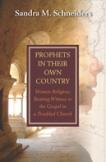Sisters of the Word
In this slender volume Sandra M. Schneiders, I.H.M., offers a historical and theological reflection on the recent interaction between American women religious and the Vatican. But far more than this, she models a solid theological methodology by which history, biblical evidence and a concrete socio-historical situation can be brought together to illuminate the challenge of revelation and the meaning of history as the locus of the drama of salvation.
Schneiders’s work emerged in response to the Vatican’s investigation of many communities of American sisters launched in January 2009. In the book’s introduction, Schneiders carefully narrates the process by which she came to write and publish her reflections and briefly lays out the themes she considers in each of the subsequent four chapters and a brief conclusion. She asks interesting questions, like, Who is paying for the investigation? since the U.S. bishops and the religious congregations themselves mostly declined the invitation to finance the project.
The first, short chapter was originally part of an e-mail conversation with colleagues, an initial response to the announcement of the Vatican investigation. It reflects the author’s understanding that the investigation has been neither benevolent nor helpful to American women religious. It also exposes briefly her understanding that the contemporary life of active women’s congregations is emerging as a new form of religious life, one that has grown organically from earlier forms but is distinct from them. She describes that evolution more fully in Chapter Three.
In a chapter entitled “Why They Stayed,” Schneiders clarifies the historical situations that shaped the unusually large influx of women into religious life during the 1940s and ‘50s and explains why this has probably created an unrealistic expectation about how big religious congregations “should be” today. Measuring the present population against this anomalous standard can create the sense that religious congregations are somehow failing. Instead, Schneiders argues, we ought to ask why those who stayed did so, and in three short but eloquent pages she portrays the contemporary character of today’s religious sisters.
Then Schneiders analyzes the evolution of what she calls “ministerial” or “apostolic” religious life. Here she integrates important historical information and identifies key historical shifts that are the crucial moments and movements for understanding the distinctive character of women’s religious life. Her analysis rests not just on sound historical data, however, but on biblical revelation: she points to the elements of Jesus’ own life as the model for ministerial religious life. This leads ineluctably to the chapter entitled “Religious Life as a Prophetic Lifeform in the Church.” In this, the longest chapter, we see distilled all of Schneiders’s formidable biblical scholarship as well as her lifelong, thoughtful commitment to the life she has chosen. She carefully lays out the meaning of biblical prophecy and reflects on the pre-paschal life of Jesus as a prophet—his divine call, the task of the prophet as he understood and lived it and his life as understood in prophetic terms.
Then she examines the ministerial life of contemporary religious women, using again the rubric of the prophetic call, task and life to explain not only the changes that American religious women have undertaken but also the distinctive characteristics of their life today. She shows how these sisters have lived a truly prophetic way of life that has both challenged and subverted the authoritarian control the Vatican is trying to reassert. Here we find the true answer to the two questions with which she began: why is the Vatican investigating the sisters, and why do the sisters object so strongly to this investigation? This is truly radical theology, in the sense that Schneiders seeks to go to the very roots of ministerial religious life in biblical revelation and in lived, historical experience. It is not, however, a call to the barricades, but a call to the most profound prayer and searching of the heart.
This project began as a response to a particular, painful event to which Schneiders returns again and again, showing how the theology and history that she integrates here illumine both the Vatican’s initiative and the responses of various groups of American women religious. But the theological and practical ramifications go beyond this one concrete situation. Religious life, from its eremitic and monastic roots onward, has been and continues to be informed by and informing of the church.
In both its method and its content, what this short book affirms about ministerial religious life is also important for ecclesiology. In the chapter on prophecy, Schneiders synthesizes what the documents of Vatican II reveal about the task of the church today, a task that she believes is shared in a special way by ministerial religious sisters. She carefully illuminates the issues of authority, power and obedience, issues of critical ecclesiological importance as well as central to the Vatican’s investigation and the sisters’ response. She reminds us of the centrality of the life of Christ to a true understanding of the church and demonstrates how the biblical texts, taproots of the church’s life, can lead us to a deeper understanding of our own historical moment and context as well as to a closer encounter with Christ.
The church in the United States has undoubtedly been enriched by the presence and ministries of the many congregations of women religious. The recent touring exhibition “Women & Spirit: Catholic Sisters in America” probably surprised many with the breadth of that service and the ardor of those ministers, even those blessed to know and be served by them. But anyone who wishes to understand their life today and the importance of their congregations to the life of the church should read Prophets in Their Own Country.
This article also appeared in print, under the headline “Sisters of the Word,” in the February 13, 2012, issue.








